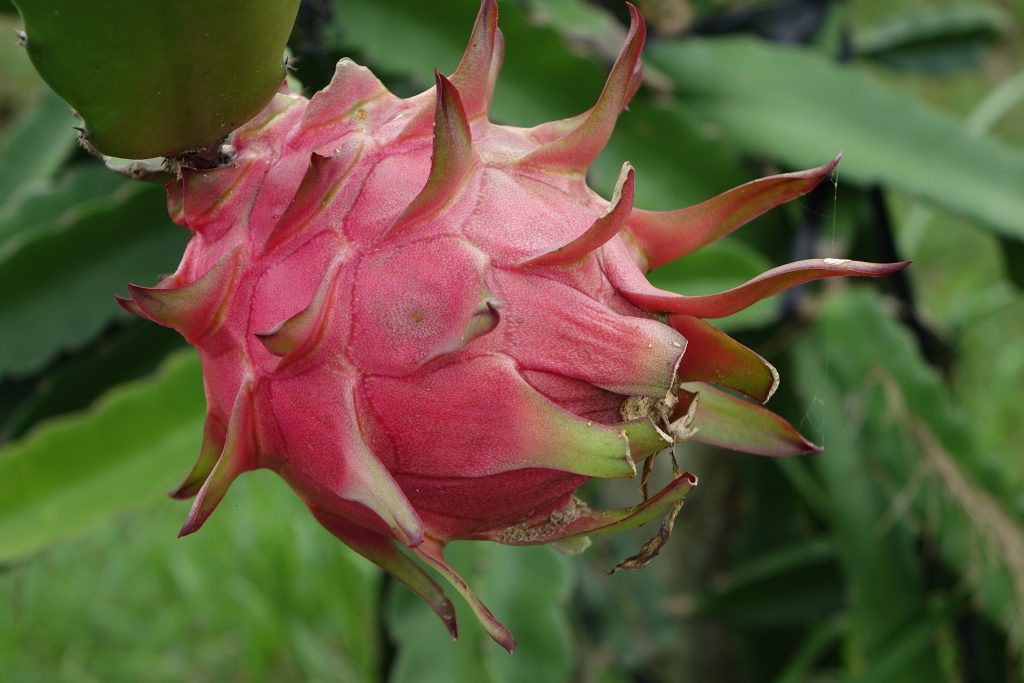Pitaya, strawberry pear, or dragon fruit – whatever you call it, this tropical fruit is one of the most unusual fruits out there both inside and out. Intimidated at the thought of eating dragon fruit? Here’s everything you need to know to demystify this tasty food.
Dragon tales
We don’t actually know where dragon fruit first grew, but it’s most likely native to Central America. About a hundred years ago, the French took the fruit to Vietnam, which is now the world’s top exporter. You can also find dragon fruit in Israel, southern China, Hawaii, the Philippines, Thailand, and other similar climates.

The dragon fruit has a very distinct look
Choosing dragon fruit
The first step to eating dragon fruit is to find one. They are available in stores year-round, though their peak is in summer and early autumn. Two have distinct pink skin, while one is yellow. Of the pink-skinned varieties, one has white flesh, while the other is red. The yellow dragon fruit is white inside. To choose the right fruit, you want even, bright skin with a slight give. Too mushy means it’s overripe, while rock-hard means you have to wait. Think of how you select an avocado. You can leave an unripe dragon fruit on the counter to get softer, but eventually, it should go in the fridge in a plastic bag.
When you’re ready to cut the fruit, carefully slice it in half. They don’t have pits, so you can slice it right in the middle. The tiny black seeds are edible. To scoop the flesh from the skin, think of an avocado again, and use a spoon. You can then slice the pieces or just eat the chunk.
What does dragon fruit taste like?
Eating dragon fruit is a bit like eating a kiwi and a pear together. It has a very delicate flavor that surprises a lot of people, considering how wild the outside of the fruit looks. In fact, many people are a bit disappointed that the flavor isn’t stronger. That hasn’t stopped the fruit from experiencing big growth in the US, however, as consumers chase new foods. It doesn’t hurt that dragon fruit is so striking visually, which is important to Instagram users and influencers. Starbucks hopped on the hype train and recently released a dragon fruit drink using the red-fleshed variety, turning the beverage a naturally-bright pink.
Because it’s flavor is so mild, where dragon fruit tends to shine is texture. It’s crunchy, so it’s a good addition to fruit salads and salsas. Flavor-wise, it’s refreshing in all kinds of drinks, smoothies, and sorbets. For savory dishes, dragon fruit matches well with white fish, tuna, and scallops. Nutritionally, dragon fruit is low in calories and a good source of vitamin C, phosphorus, fiber, calcium, and antioxidants.
Interested in trying a recipe? Here’s one for a salsa that’s great with seafood:
Dragon Fruit Salsa
1 cup of peeled and cubed dragon fruit (any color)
1 minced shallot
1 tablespoon lime juice
1 sliced jalapeno
1 tablespoon chopped mint
Prep all the ingredients and then toss together in a bowl. Serve over your fish or scallops.
————-
Dragon fruit is trending, and so are other “exotic” flavors like pandan. What is this plant and how are people using it?




